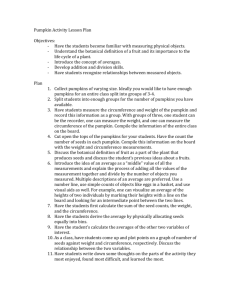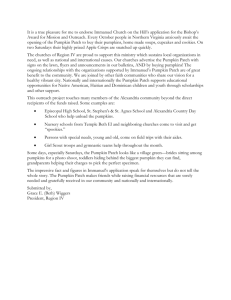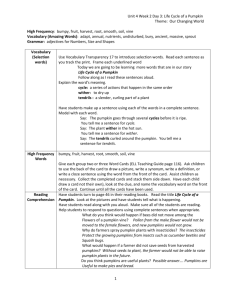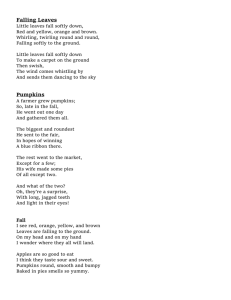Pumpkin Mousse - First Coast Academy of Nutrition and Dietetics
advertisement
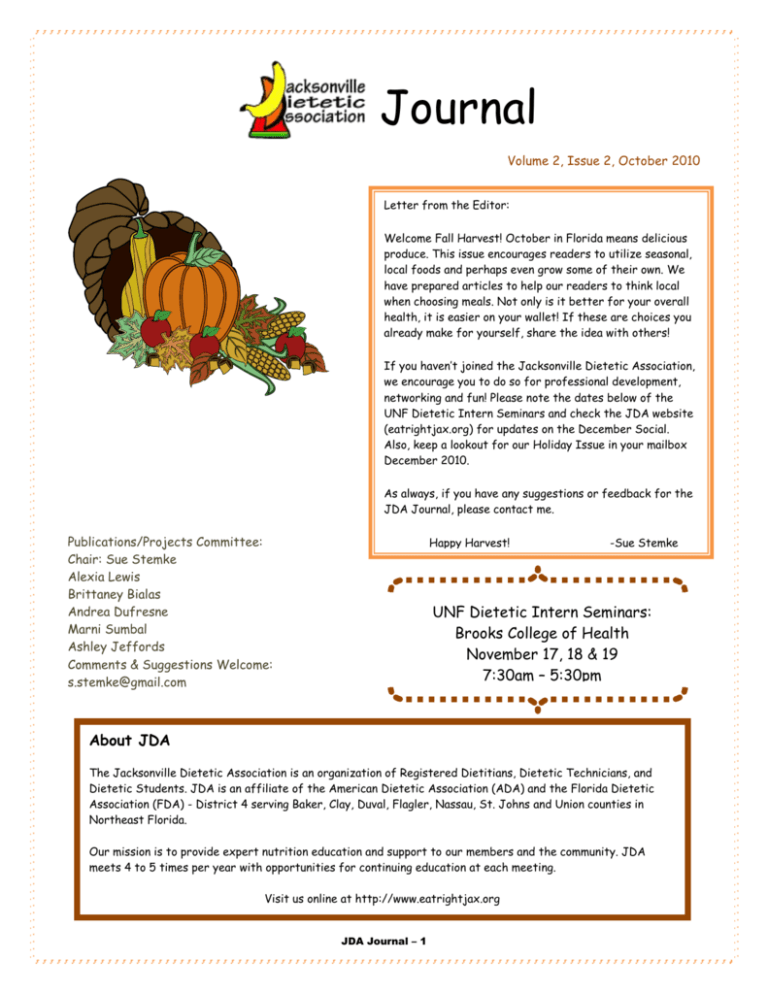
Journal Volume 2, Issue 2, October 2010 Letter from the Editor: Welcome Fall Harvest! October in Florida means delicious produce. This issue encourages readers to utilize seasonal, local foods and perhaps even grow some of their own. We have prepared articles to help our readers to think local when choosing meals. Not only is it better for your overall health, it is easier on your wallet! If these are choices you already make for yourself, share the idea with others! If you haven’t joined the Jacksonville Dietetic Association, we encourage you to do so for professional development, networking and fun! Please note the dates below of the UNF Dietetic Intern Seminars and check the JDA website (eatrightjax.org) for updates on the December Social. Also, keep a lookout for our Holiday Issue in your mailbox December 2010. As always, if you have any suggestions or feedback for the JDA Journal, please contact me. Publications/Projects Committee: Chair: Sue Stemke Alexia Lewis Brittaney Bialas Andrea Dufresne Marni Sumbal Ashley Jeffords Comments & Suggestions Welcome: s.stemke@gmail.com Happy Harvest! -Sue Stemke UNF Dietetic Intern Seminars: Brooks College of Health November 17, 18 & 19 7:30am – 5:30pm About JDA The Jacksonville Dietetic Association is an organization of Registered Dietitians, Dietetic Technicians, and Dietetic Students. JDA is an affiliate of the American Dietetic Association (ADA) and the Florida Dietetic Association (FDA) - District 4 serving Baker, Clay, Duval, Flagler, Nassau, St. Johns and Union counties in Northeast Florida. Our mission is to provide expert nutrition education and support to our members and the community. JDA meets 4 to 5 times per year with opportunities for continuing education at each meeting. Visit us online at http://www.eatrightjax.org JDA Journal – 1 By Ashley Jeffords As the cool air blows and the leaves change colors, we know Fall is upon us. When you think of a “Fall Harvest,” what foods do you think of? Apples? Corn? How about Pumpkins!? What exactly is a pumpkin? A Pumpkin is a squash-like fruit of the genus Cucurbita and the family Cucurbitaceae. This genus typically grows on vines and includes other common crops such as cucumbers, gourds and winter squashes. Now, you may be thinking…What!? Pumpkins are a Fruit? Yes, botanically and scientifically speaking a pumpkin and the rest of its gourd-like squash family are fruits because they have seeds and are the ripened ovary of a flowering plant. But if you are speaking in culinary terms, they can be called VEGETABLES. “Vegetable” is a culinary term. Its definition has no scientific value and is somewhat subjective. All parts of herbaceous plants eaten by humans are generally considered vegetables. So there you have it, just like a tomato, a pumpkin is a fruit AND a vegetable. Although pumpkins are usually orange or yellow, some are dark green, pale green, white, red and gray. Pumpkins range in size from less than 1 pound to over 1,000 pounds, with the largest ever recorded weighing in at 1,140 pounds. Pumpkins are grown all around the world. The top states in the US to grow pumpkins are Illinois, Ohio, Pennsylvania and California. Illinois provides around 90 to 95% of the processed pumpkins. There are four species of Cucurbita found in North America, which can be distinguished through differences in their stems; Cucurbita pepo, Cucurbita maxima, Cucurbita moshata, and Cucurbita moshata. Pumpkins can also be described by how they grow. There are vining pumpkins, semi-bush pumpkins, bush pumpkins, and miniature pumpkins. Pumpkins are very tender and prefer warmer temperatures above 70° during the day and no lower than 60° at night. The seeds do not germinate in cold soil, and the seedlings are injured by frost. Pumpkins typically mature and give fruit within 90 to 120 days of being planted. Pumpkins can be harvested whenever they are a deep, solid color and the rind is hard. If vines remain healthy, harvest in late September or early October. Eighty percent of the pumpkin supply in the US is available in October. Pumpkins are 90% water and most parts are edible, including the fleshy shell, the seeds, the leaves, and even the flowers. The bright orange color shows that pumpkins are loaded with an important antioxidant, beta-carotene. Beta-carotene is one of the plant carotenoids converted to vitamin A in the body. Current research indicates that diets with foods rich in beta-carotene may reduce the risk of developing certain types of cancer and protect against heart disease as well as other diseases. Pumpkins also contain nutrients such as lutein, alpha carotenoids and potassium. Pumpkin seeds also have many health benefits. They are a good source of protein, zinc, and other vitamins, and are even said to lower cholesterol. One gram of pumpkin seed protein contains as much tryptophan as a full glass of milk. Pumpkin seeds are a good source of magnesium, manganese, phosphorus, and phytosterols. JDA Journal – 2 Pumpkin Nutrition Facts: Calories 49 Protein 2g Carbohydrate 12g Dietary Fiber 3g Iron 1.4mg (1 cup cooked, boiled, drained, without salt) Zinc 1mg Selenium .50mg Vitamin C 12mg Niacin 1mg Folate 21 mcg Vit A 2650 IU Calcium 37mg Vit E 3mg Magnesium 22mg Potassium 564mg Pumpkin Mousse Light and rich taste, but low in fat and calories. Ingredients: 2/3 cup fat free evaporated milk ¼ tsp ground cinnamon 1 cup pumpkin 1 package vanilla pudding and pie filling 1 ½ cups low fat frozen whipped topping Directions: 1. Combine pudding mix, evaporated milk, pumpkin 2. And cinnamon in a bowl until well combined. 3. Gently fold in the whipped topping. 4. Cover and refrigerate for at least one hour before serving. Serves 6. Each serving is approximately 1/2 cup. Nutrition Summary: There are 140 calories in 1 serving of Pumpkin Mousse Calorie break-down: 17% fat, 74% carbs, 9% protein. N u t r i t i on F a c t s Serving Size 1 serving Amount Per Serving Calories from Fat 25 Calories 140 % Daily Values* Total Fat 2.73g Saturated Fat 2.28g 4% 11% Polyunsaturated Fat 0.06g Monounsaturated Fat 0.21g Cholesterol 2mg Sodium 286mg 1% 12% Potassium 201mg Total Carbohydrate 26.38g 9% Dietary Fiber 1.2g Sugars 24.35g Protein 3.18g JDA Journal – 3 5% Seasonal Eats! By Marni Sumbal Do you find yourself spending more money on groceries in the summer, as opposed to the winter? There’s something so refreshingly beautiful about the abundance of fresh fruits and vegetables in the summer months. With a dietary emphasis on plant-based, wholesome foods, it’s easy to splurge on the wonderful assortment of summer fruits and veggies. As you strive for a diet filled with powerful nutrients, your local grocery store is about to welcome many fruits and vegetables, perfect for your fall and winter recipes. Foods you can expect to find in high quantity, as well as at a reasonable price, include (but not limited to): Acorn Squash, Belgian Endive, Brussels Sprouts, Butternut Squash, Chestnuts, Clementines, Collard Greens, Cranberries, Dates, Ginger, Grapefruit, Guave, Kumquats, Leeks, Passion Fruit, Pummelo, Pumpkin, Quince, Radicchio, Sweet Potatoes, Swiss Chard, Turnips. Did you know that a typical carrot has to travel 1,838 miles to reach your dinner table¹? Don’t forget to check out your local farmer’s market for the best produce (and deals) in the Jacksonville area! Top 10 benefits of farmers’ markets: 1) Reduced need for packaging. 2) Direct contact and feedback between customer and producer on produce and prices. 3) Avoiding the middleman increases financial returns for local growers. 4) Improve diet by providing access to fresh and wholesome food. 5) Source of information on fresh ingredients. 6) Reduce food miles (ex. vehicle pollution, noise and fossil fuel use). 7) Encourage environmentally safe production practices (ex. organic or pesticide free). 8) Encourage social interaction. 9) Stimulate local economic development by increasing employment. 10) Fresh Food Tastes GOOD! JDA Journal – 4 Acorn Squash and Apple Soup: Ingredients: 1 Acorn Squash (about 1 1/2 pounds) 2 tsp canola oil 1 medium onion, finely chopped 1 large Granny Smith Apple, peeled, cored, and chopped into 1/2-inch pieces 2 tsp curry powder 2 cups fat-free, low-sodium chicken broth Preparation: Pierce acorn squash with a fork, and place on a paper towel in the microwave for 8-10 minutes. Pierce with tip of knife to see if it’s tender. Carefully remove from microwave. Allow to cool, and then halve the acorn squash lengthwise. Scoop out seeds and fibers. Meanwhile, heat oil in a medium pot or Dutch oven. Sauté onions and apples for 5 minutes, until softened. Sprinkle curry powder and stir well. Scoop the flesh of the acorn squash from the skin and add to pot. Discard skin. Pour in chicken or vegetable broth. Bring to a boil, then cover and simmer for 15 minutes. Using a hand blender or a regular blender, puree the soup until smooth. Serves 4 Per Serving: Calories 145, Calories from Fat 2.8g (sat 0.2g), Cholesterol 0mg, Sodium 37mg, Fiber 4.3g, Protein 2.6g http://lowfatcooking.about.com/od/soup1/r/acornapplesoup.htm JDA Journal – 5 Gardening: before one can harvest, one must plant By Alexia Lewis Gardening is a simple concept with a complicated list of things to know hiding behind it. Everyone is doing it though. In the Jacksonville area, the Neptune Beach farmer’s market has garden space for residents. There are community gardens in Springfield, Arlington, Argyle and other areas throughout town. University of North Florida students have a “verb” (vegetable and herb) garden on campus and they are also involved with starting a garden at the Clara White Mission. The City of Jacksonville has an Urban Garden Program that offers five community gardens for residents to use on a first come, first served basis. The first lady even started a garden at the White House. Why the gardening craze? There are as many reasons as there are gardeners. At one end of the range is the desire to have more control over how our food is produced – with fewer chemicals, less bioengineering, and a smaller carbon footprint. At the other end of the range is the fulfillment found from digging in the dirt and eating what one has grown. Regardless of the reasons, gardening is becoming more popular. A garden’s success depends in big part on preparation. Dirt is not just dirt. Soil must have the right composition of clay, sand, and silt, the right pH, and a favorite of dietitians, the right nutrients. One great tip from TLC’s Web site is to look at the weeds in the intended garden area. If there are not many weeds, then the soil will need to be prepared before other plants will grow well. If weeds are growing but are discolored and stunted, the soil should be tested to see which nutrients will need to be added to the soil. Soil should also be aerated and this is a good chance to take one more look at the weeds. After tilling the soil, look for the areas where new weeds grow quickly because this will be the best soil in the plot. One could examine and identify weeds, test soil, aerate and add needed nutrients… or one could go the easier route and try container gardening. Simply head to the garden store for some pots, garden soil, and seeds or starter plants, and you are ready to plant! Okay, well, not exactly. There are many options for pots. Look for pots that are big enough to accommodate the size of the mature plant and have holes in the bottom for drainage. To assist with drainage, gather rocks, or something similar, to put into the bottom of the pot as a first layer. Then pour some garden soil on top of the rocks. The last step is planting the seeds or starter plants and then watering right away. From there, it’s just maintenance – simply water adequately and feed when needed. Autumn is traditionally the time of harvest; but in Florida, it’s also a good time to plant. The important factors in deciding what to plant are hardiness zones, seasons, and the level of sun and shade in the garden. The hardiness zone indicates which plants will thrive best in a specific climate. JDA’s district is in hardiness zones 8b and 9a. Seed packages list plant’s hardiness zones and this can be one way to figure out what to plant in the JDA area. According to University of Florida Institute of Food and Agricultural Sciences (IFAS), this is the season in which to plant bush/pole beans, winter/summer squash, broccoli, cauliflower, carrots, cucumbers, cabbage, collards, kale, lettuce, spinach, onions, radish, beets, turnips, and strawberries. Lastly, some plants need full sun, others need shade, so how much sun the garden gets will determine what will grow best. If the garden gets partial shade, the best options will be beans, beets, broccoli, cauliflower, and salad/leafy greens. “Gardening suggests there might be a place where we can meet nature halfway” -Michael Pollan JDA Journal – 6
